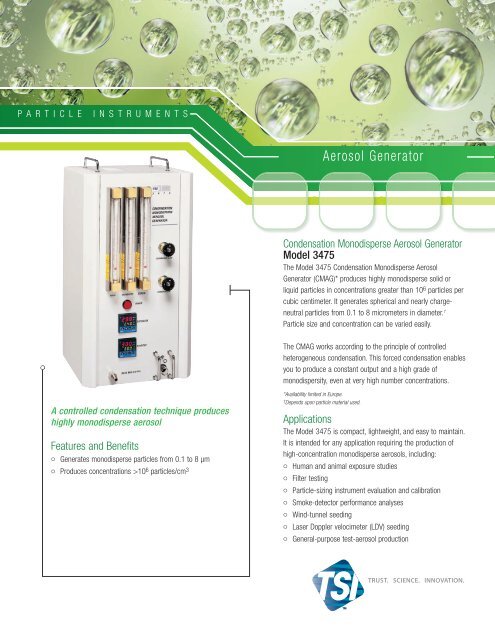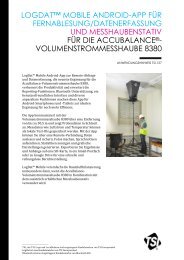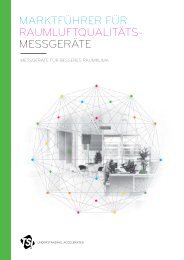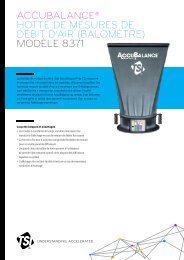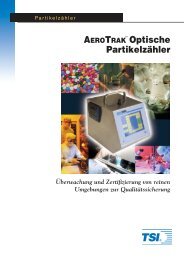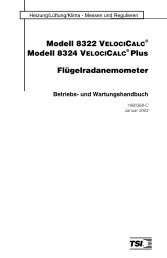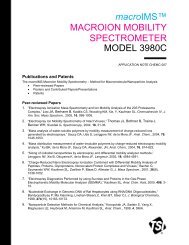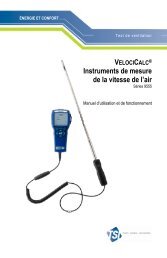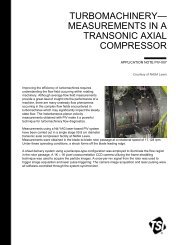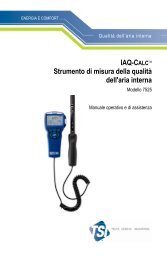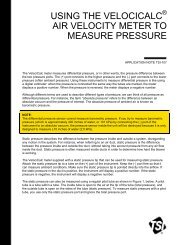Condensation Monodisperse Aerosol Generator Model 3475 - TSI
Condensation Monodisperse Aerosol Generator Model 3475 - TSI
Condensation Monodisperse Aerosol Generator Model 3475 - TSI
Create successful ePaper yourself
Turn your PDF publications into a flip-book with our unique Google optimized e-Paper software.
PARTICLE INSTRUMENTS<br />
A controlled condensation technique produces<br />
highly monodisperse aerosol<br />
Features and Benefits<br />
Generates monodisperse particles from 0.1 to 8 μm<br />
Produces concentrations >10 6 particles/cm 3<br />
<strong>Condensation</strong> <strong>Monodisperse</strong> <strong>Aerosol</strong> <strong>Generator</strong><br />
<strong>Model</strong> <strong>3475</strong><br />
The <strong>Model</strong> <strong>3475</strong> <strong>Condensation</strong> <strong>Monodisperse</strong> <strong>Aerosol</strong><br />
<strong>Generator</strong> (CMAG)* produces highly monodisperse solid or<br />
liquid particles in concentrations greater than 10 6 particles per<br />
cubic centimeter. It generates spherical and nearly chargeneutral<br />
particles from 0.1 to 8 micrometers in diameter. †<br />
Particle size and concentration can be varied easily.<br />
The CMAG works according to the principle of controlled<br />
heterogeneous condensation. This forced condensation enables<br />
you to produce a constant output and a high grade of<br />
monodispersity, even at very high number concentrations.<br />
*Availability limited in Europe.<br />
†Depends upon particle material used.<br />
<strong>Aerosol</strong> <strong>Generator</strong><br />
Applications<br />
The <strong>Model</strong> <strong>3475</strong> is compact, lightweight, and easy to maintain.<br />
It is intended for any application requiring the production of<br />
high-concentration monodisperse aerosols, including:<br />
Human and animal exposure studies<br />
Filter testing<br />
Particle-sizing instrument evaluation and calibration<br />
Smoke-detector performance analyses<br />
Wind-tunnel seeding<br />
Laser Doppler velocimeter (LDV) seeding<br />
General-purpose test-aerosol production
Operation<br />
The <strong>Model</strong> <strong>3475</strong> CMAG uses a controlled condensation technique to<br />
produce monodisperse aerosols. Based on the Sinclair-LaMer principle,<br />
this operational approach involves condensing a vapor onto<br />
condensation nuclei.<br />
Using nitrogen as the carrier gas, an atomizer inside the CMAG<br />
produces a spray from a low-concentration, aqueous solution of sodium<br />
chloride. The droplets pass through a drying column, where they dry to<br />
form a high-concentration nuclei aerosol. The condensation nuclei travel<br />
to a thermostatically controlled saturator vessel and bubble through a<br />
substance with low volatility, such as diethylhexyl sebacate (DEHS),<br />
dioctyl phthalate (DOP), Emery 3004, or paraffin or carnauba waxes.<br />
The carrier gas, nuclei, and vaporized substance move from the<br />
saturator into a reheater unit, which serves to ensure that the aerosol<br />
material is completely vaporized. From the reheater unit, the nuclei and<br />
vapor move into an air-cooled condensation chimney. It is here that,<br />
N2<br />
Flow<br />
Valve<br />
HEPA Filter<br />
Atomizer<br />
Flowmeter<br />
(total)<br />
Diffusion<br />
Dryer<br />
Screen<br />
once a preset supersaturation level has been reached, the controlled<br />
heterogeneous condensation process begins, resulting in a highly<br />
monodisperse aerosol.<br />
Concentration (particles/cm 3 )<br />
10 4<br />
5x10 3<br />
Flowmeter<br />
(screen-bypass)<br />
0<br />
0.7 1 2 3 5 7 10<br />
Aerodynamic Particle Diameter (m)<br />
<strong>Monodisperse</strong> aerosol produced by the <strong>Model</strong> <strong>3475</strong> using the reduction of the<br />
nuclei number concentration<br />
Flowmeter<br />
(saturator)<br />
Heated Saturator<br />
Flow Valve Flow Valve<br />
<strong>Condensation</strong><br />
Chimney<br />
Reheater<br />
<strong>Monodisperse</strong><br />
aerosol out
Mean particle size is dependent on the ratio of the vapor concentration<br />
to the nuclei number concentration. You can control vapor concentration,<br />
and therefore, particle size by adjusting the saturator temperature and<br />
the proportion of the total flow passing through the saturator unit.<br />
The CMAG allows you to make very rapid changes to particle size over a<br />
limited range by varying the saturator flow rate alone. For instance, with<br />
DOP or DEHS, only three different temperature settings are required to<br />
cover the range from 0.1 to 5 micrometers. The generator’s specially<br />
designed aerosol outlet meets the requirement for high monodispersity<br />
by selecting the central flow where the temperature gradient is lowest<br />
and, consequently, the size distribution is narrowest. To produce<br />
monodisperse aerosol with particles up to 8 micrometers, you must<br />
divert a portion of the nuclei through a filter, reducing the nuclei number<br />
concentration in a controlled manner until you achieve a higher relative<br />
concentration of vapor.<br />
Process <strong>Aerosol</strong> Monitor Accessory<br />
An accessory is available to measure the mean particle size and<br />
concentration of monodisperse aerosols produced with <strong>TSI</strong>’s<br />
<strong>Condensation</strong> <strong>Monodisperse</strong> <strong>Aerosol</strong> <strong>Generator</strong> (CMAG). The <strong>Model</strong><br />
3375 Process <strong>Aerosol</strong> Monitor (PAM) connects directly to the CMAG<br />
outlet, monitoring output aerosol on a continuous basis. As the highly<br />
concentrated aerosol flows through a measuring volume, the PAM uses<br />
a photodetector to correlate particle size and concentration with laser<br />
intensity. It measures particles in the 0.5 to 10-micrometer range.<br />
Concentration is determined independent of the extinction coefficient<br />
<strong>Model</strong> <strong>3475</strong><br />
CMAG<br />
<strong>Model</strong> 3375 PAM<br />
The PAM monitors monodisperse aerosol produced using a <strong>Model</strong> <strong>3475</strong> CMAG.<br />
Bibliography<br />
Altmann J and C Peters, The Adjustment of the Particle Size at a Sinclair-La<br />
Mer-Type <strong>Aerosol</strong> <strong>Generator</strong>, J. <strong>Aerosol</strong> Science 23(Supplement 1):S277-S280<br />
(1992)<br />
Peters C and J Altmann, <strong>Monodisperse</strong> <strong>Aerosol</strong> Generation with Rapid Adjustable<br />
Particle Size for Inhalation Studies, J. <strong>Aerosol</strong> Medicine 6(4):307-315 (1993).<br />
(<strong>TSI</strong> paper A86)<br />
Specifications<br />
<strong>Model</strong> <strong>3475</strong> <strong>Condensation</strong> <strong>Aerosol</strong> <strong>Generator</strong><br />
Mode of Operation<br />
Modified Sinclair-LaMer generator<br />
Particle Type<br />
Liquid DES (nontoxic), DOP, or Emery 3004<br />
Solid Carnauba wax (nontoxic), paraffin, or stearic acid<br />
Particle-Size Range for Selected Materials<br />
DEHS, DOP 0.1 to 8 μm<br />
Carnauba Wax 0.1 to 4 μm<br />
Stearic Acid 0.1 to 9 μm<br />
<strong>Aerosol</strong> Geometric Standard Deviation<br />
PARTICLE INSTRUMENTS<br />
<strong>TSI</strong> Incorporated - 500 Cardigan Road, Shoreview, MN 55126-3996 USA<br />
USA Tel: +1 800 874 2811 E-mail: answers@tsi.com Website: www.tsi.com<br />
UK Tel: +44 149 4 459200 E-mail: tsiuk@tsi.com Website: www.tsiinc.co.uk<br />
France Tel: +33 491 11 87 64 E-mail: tsifrance@tsi.com Website: www.tsiinc.fr<br />
Germany Tel: +49 241 523030 E-mail: tsigmbh@tsi.com Website: www.tsiinc.de<br />
India Tel: +91 80 41132470 E-mail: tsi-india@tsi.com<br />
China Tel: +86 10 8251 6588 E-mail: tsibeijing@tsi.com<br />
Singapore Tel: +65 6595 6388 E-mail: tsi-singapore@tsi.com<br />
Contact your local <strong>TSI</strong> Distributor or visit our website www.tsi.com for more detailed specifications.<br />
P/N 1931229 Rev B Copyright © 2011 by <strong>TSI</strong> Incorporated Printed in U.S.A.<br />
<strong>Aerosol</strong> <strong>Generator</strong>


